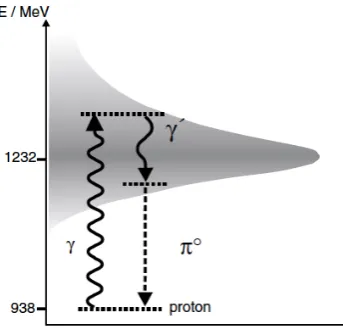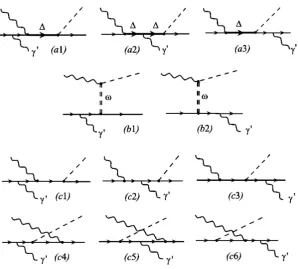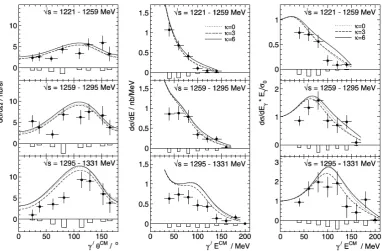Magnetic Moments of Excited Baryons
VolkerMetag1,
1II. Physikalisches Institut, Universität Gießen, Heinrich Buff Ring 16, 35392 Gießen
Abstract.In projectA.3, the reactionγp→π0γ’phas been studied using the TAPS photon spectrometer in the energy range√s=1221-1331 MeV. Energy tagged photon beams have been produced with the Glasgow tagging spectrometer from electron beams provided by the MAMI-B accelerator. Angle and energy differential cross sections have been measured and compared to theoretical calculations. This comparison allows the magnetic moment of theΔ+isobar to be extracted for the first time toμΔ+ =[2.7+1.3
−1.0(stat)±1.5(syst)±3(theo)]μN. In an extension of the A3 project to the meson sector, the time-like transition form factor of theηmeson has been measured with the Crystal Ball/TAPS detector system at MAMI-C.
1 Introduction
The main goal of the Transregio TR16 is to explore the excitation energy spectrum of the nucleon in order to un-ravel its complex structure. Apart from determining the mass, width and quantum number of excited states, infor-mation on the polarizability, magnetic moments and form factors provide further insight in the structure of the nu-cleon. For baryon ground states these properties have been measured with great precision. Corresponding informa-tion on excited states has so far been lacking. Because of its prominent position in the excitation energy spectrum, the properties of theΔ(1232) resonance are of particular importance.
Figure 1. Scheme for studying the static electromagnetic prop-erties of theΔ(1232) isobar. Theγ’ transition carries the infor-mation on the magnetic moment of theΔ+.
e-mail: Volker.Metag@exp2.physik.uni.giessen.de
Following pioneering experiments determining the magnetic moment of theΔ++ resonance [1, 2], a first at-tempt has been made within the A3 project to measure the magnetic moment of theΔ+ resonance. The idea of the experiment is sketched in Fig. 1. The broadΔ+resonance (Γ =120 MeV) is populated in the high mass regime via photon excitation, followed by a γ transition within the resonance and a subsequentπ0decay of theΔ+resonance
to the nucleon ground state. Spin and parity conservation require that - to lowest multipole order - thisγ’ transition is of magnetic dipole (M1) type. The next allowed mul-tipole is electric quadrupole (E2), but the E2/M1ratio of theΔ- N transition has been measured to be small (0.025) [3], indicating a small quadrupole deformation of theΔ+ resonance. The magnetic octupole transition (M3) is sup-pressed by two additional powers of the photon energy. Thus, the measurement of theγp → π0γ’preaction
pro-vides access toμΔ+. The sensitivity of theΔ+→Δ+γ’ am-plitude to the magnetic momentμΔ+has been investigated theoretically by Machavariani et al. [4, 5] and Drechsel [6]. The sameπ0γ’pfinal state can, however, also result from bremsstrahlung radiation of theΔ+or the proton. For a comparison with the experiment, these channels have to be included in a calculation as in [7]. Fig. 2 shows the graph of interest (a2) and all other graphs contributing to theγp → π0γ’preaction. Our experimental data will be
compared to these extended calculations by Drechsel and Vanderhaegen [7].
2 The experiment
The reactionγp → π0γ’p was measured at the electron
accelerator MAMI-B, using the Glasgow Tagged photon facility [8] and the photon spectrometer TAPS [9, 10]. A quasi monochromatic photon beam was produced in the energy range of 205-820 MeV via bremsstrahlung tagging. The 510 hexagonal BaF2TAPS modules were arranged in
DOI: 10.1051/
,02003 (2017) 713402003
EPJ Web of Conferences 134 epjconf/201
Figure 2.Diagrams considered in the calculation of theγp→π0γ’preaction in theΔ(1232) energy region [7].
a horizontal plane around the liquid hydrogen target in 6 blocks of 62 detectors and a forward wall of 138 detec-tors. The setup covered about 40% of the full solid angle. Further details of the experimental setup and the running conditions can be found in [11].
3 Data analysis
Theγp → π0γ’p was measured exclusively since the
4-momentum vectors of all final state particles were deter-mined. Theπ0 mesons were detected via their two
pho-ton decay and identified via an invariant mass analysis. The third photon in the final state was assigned to theγ’ transition. The protons were identified by time-of-flight, exploiting the excellent time resolution of TAPS, and by the energy deposited in the BaF2 crystals. The main
ex-perimental background was the 2π0channel where one of the 4 decay photons escaped undetected. This background could be removed by a cut in theπ0pmissing mass
spec-trum shown in Fig. 3. For theγp → π0γ’preaction the
missing mass is 0, while 2π0events with one decay photon
lost were centered around a missing mass of 0.02 GeV2.
4 Results
The measured angle and energy differential cross sections are shown in Fig. 4. For the higher incident photon ener-gies a clear deviation from a 1/Eγ bremsstrahlung distri-bution is observed, indicating contridistri-butions fromγ’ tran-sitions within theΔ+resonance. The data are compared with calculations by Drechsel and Vanderhaegen [7] for
Figure 3.Missing mass of theπ0psystem for two incident pho-ton energy bins. The peak near 0.02 GeV2originates from 2π0 production and is cut away. The peak at 0 GeV2 corresponds to theπ0γ’pexit channel. The dashed and dotted curves show the corresponding line shapes simulated with GEANT3.
different values ofκΔ+, related to the magnetic moment of
theΔ+resonance by
μΔ+=(1+κΔ+)mN
mΔμN. (1)
The calculations follow the overall shape of the experi-mental distributions but overestimate the data for the high-est excitation energy. A model independent determination of the γp → π0γ’p cross section is possible in the soft
Figure 4.Differential cross sections for three excitation energy bins√sin the center of mass system. The curves represent calculations [7] forκΔ+=0, 3, and 6. Bars indicate the systematic errors. (Left) Angular distribution of theγ’ photon. (Middle) Energy distribution of theγ’ photon. (Right) Energy distribution divided by the soft photon limitσ0
Eγ for data and calculations.
π0pproduction in the limit of vanishing photon energyE
γ.
The ratio of both cross sections approaches unity for small transition energiesEγ(see Fig. 4). The cross section ratios
are less sensitive to experimental and theoretical uncer-tainties and are thus used to extractμΔ+. A combined
max-imum likelihood analysis of all three cross section ratios in Fig. 4 (right column) gives a magnetic moment of theΔ+ resonance of μΔ+ = [2.7+1.3
−1.0(stat)±1.5(syst)±3(theo)] μN;
the goodness of the fit isχ2/f =1.8 (f = 21). The first error represents the statistical uncertainty, and the second one reflects the systematic errors of the experiment indi-cated in Fig. 4. The systematic uncertainty of the model calculation is estimated to be≈ ±3 μN. This determina-tion ofμΔ+ is unfortunately not precise enough to allow a
detailed test of different baryon structure calculations.
The above analysis is simplified in so far as the magnetic moment of theΔ- as of any other unstable state - is a complex quantity. Treating the Δ as a resonance (not as a stable particle), an explicit prescription has been developed in project A6 how to extract the ΔNγ∗ transition form factor from lattice data [12].
In continuation of the A3 project a follow-up experi-ment was performed at MAMI-B employing the Crystal Ball/TAPS detector system with almost full coverage of the solid angle. The improved experimental conditions led to 60 times higher statistics. The results of these measurements were published in [13]. Despite of the much better data set an improved value of the magnetic momentμΔ+ could not be extracted because the available
calculations did not reproduce in detail the measured high statisticsγ’ angle and energy distributions.
5 The time-like transition form factor of
the
η
meson
In an extension of project A3 to the meson sector the time-like transition form factor of the ηmeson has been measured using the Crystal Ball/TAPS detector system at MAMI-C. Electromagnetic transition form factors are an important tool for studying the intrinsic structure of hadrons. The decay of light pseudoscalar mesons π0, η,
andη as well as vector mesonsρ, ω andφ allow a test of the vector meson dominance (VMD) conjecture where the coupling of a photon to a hadron is mediated by a virtual vector meson. For point-like particles the decay rates can be exactly calculated within Quantum Electrody-namics (QED). Information on the intrinsic structure of mesons is encoded in the multiplicative transition form factor. The transition form factors can be studied for mo-mentum transfers not accessible in annihilation or scatter-ing experiments. Furthermore, new theoretical efforts aim-ing at a systematic description of light pseudoscalar and vector mesons and their couplings to electromagnetism [14] can be tested. An overview over earlier work in this field can be found in [15].
In this experiment theηDalitz decayη → γγ∗ → γ e+e−with a branching ratio of 6·10−3 has been
investi-gated. The reconstruction of such a weak decay channel is a major experimental challenge and could only succeed
DOI: 10.1051/
,02003 (2017) 713402003
EPJ Web of Conferences 134 epjconf/201
Figure 5. Distribution of reconstructed e+e−γcandidate events after applying the selection cuts. The lower figure shows the projection onto the e+e−γinvariant mass axis [16].
by using the almost complete 4πcoverage of the combined Crystal Ball and TAPS detector system at MAMI-C. The disadvantage of the detector system is that it does not pro-vide a magnetic field for charged particle tracking. Only the energy and angle of registered particles is available and the information whether they are charged or neutral. The sign of the charge cannot be determined.
The identification of this weak decay channel required a series of cuts described in detail in [16]. These cuts re-duced the reconstruction efficiency of theγp → pη → pγe+e− reaction to about 5%. For events that have sur-vived these cuts the correlation between the e+e−invariant mass and the e+e−γinvariant mass as well as the projection on the e+e−γinvariant mass axis are shown in Fig. 5. A total of 1345η →γe+e−events residing on a small back-ground could be reconstructed. Fitting the γe+e− mass spectra for different slices in Masse+e−, the Masse+e− distri-bution shown in Fig. 6 is obtained. The mass distridistri-bution is compared to the QED prediction for a point-like meson. Dividing the measured Masse+e− distribution by the QED prediction, the time-like transition form factor of theη me-son is obtained as shown in Fig. 7. Fitting the form factor using the standard VMD parametrization
F(m2)= 1
1−(m/Λ)2, (2)
a value ofΛ−2 = (1.92±0.35(stat)±0.13(syst) ) GeV−2
is obtained corresponding to Λ = (720 ±60(stat)±25
Figure 6. Invariant e+e− mass distribution of reconstructed events after acceptance correction [16].The errors given are purely statistical.The solid curve is a fit within the VMD-model, using a monopole form factor (Eq. 2). The dotted curve is the QED prediction.
(syst)) MeV. The systematic error is estimated from a comparison of results obtained for different cut settings. The statistics is improved by an order of magnitude compared to the most recent form factor measurement in the e+e− channel [17]. The data are in good agreement with the high statistics NA60 data, obtained in theμ+μ− channel, however, without a full reconstruction of the
η meson, and with recent theoretical calculations [19]. After establishing in this pioneering experiment that weak
Figure 7. Dalitz transition form factor. The red circles are the data of this work and the black curve is a fit to these data [16]. The green (open) circles show the result of the SND experiment [17]. The blue (inverted) triangles represent the results obtained by the NA60 collaboration in theμ+μ−channel [18]. The green (dashed) curve is a calculation performed by [19].
calorimeter without magnetic field, a series of measure-ments has been performed within the A2 collaboration at MAMI. An improved measurement of theηDalitz decay has been reported in [20]. Including all runs on a liquid hydrogen target and applying kinematic fitting routines a large data set has been accumulated for further improving theηform factor determination and to extend the analysis to theω → π0e+e−Dalitz decay [21]. On the theoretical
side, improved calculations based on dispersion theory have been performed within project B3 for theη, ωandφ transition form factors [22, 23].
I would like to thank all the colleagues in the A2 collaboration at MAMI for their support and contributions to the results described in this article. The results are based on the theses of the strongly engaged PhD-students M. Kotulla and H. Berghäuser. Illuminat-ing discussions with D. Drechsel, V. Pascalutsa and M. Vander-hagen on the theoretical interpretation of the data are highly ap-preciated. The work reported here would not have been possible without the support from the Deutsche Forschungsgemeinschaft within the SFB/TR16.
References
[1] B. Nefkenset al.,Phys. Rev. D18, 3911 (1978). [2] A. Bosshardet al.,Phys. Rev. D44, 930 (1991). [3] R. Becket al.,Phys. Rev. Lett.78, 606 (1997). [4] A. Machavariani, A. Faessler and A. Buchmann, Nucl.
Phys. A646, 231 (1999).
[5] A. Machavariani, A. Faessler and A. Buchmann, Nucl. Phys. A686, 601 (2002).
[6] D. Drechsel, Phys. Lett. B484, 236 (2000).
[7] D. Drechsel and M. Vanderhaegen, Phys. Rev. C64, 065202 (2001).
[8] S. Hallet al.,Nucl. Inst. Methods Phys. Res. A368, 698 (1996).
[9] R. Novotny, et al., IEEE Trans. Nucl. Sci 38, 392 (1991).
[10] A. R. Gableret al.,Nucl. Instr. Methods Phys. Res. A346, 168 (1994).
[11] M. Kotullaet al.,Phys. Rev. Lett.89, 278001 (2002). [12] A. Agadjanovet al.,Nucl. Phys. B886, 1199 (2014). [13] S. Schumanet al.,Eur. Phys. J. A43, 269 (2010). [14] M. F. M. Lutz and S. Leupold, Nucl. Phys. A813, 96
(2008).
[15] L. G. Landsberg, Phys. Rep.128, 301 (1985). [16] H. Berghäuseret al., Phys. Lett. B701, 562 (2011). [17] M. N. Achasovet al.,Phys. Lett. B504, 275 (2001). [18] R. Arnaldiet al.,Phys. Lett. B677, 260 (2009). [19] C. Terschlüsen, Diploma thesis, Univ. of Giessen,
2010.
[20] P. Aguar-Bartolomeet al.,Phys. Rev. C89, 044608 (2014).
[21] S. Prakhov, private communication (2016). [22] C. W. Xiaoet al.,arXiv:1509.02194.
[23] S. P. Schneideret al.,Phys. Rev. D86054013 (2012).
DOI: 10.1051/
,02003 (2017) 713402003
EPJ Web of Conferences 134 epjconf/201



![Figure 6.Invariant e+e− mass distribution of reconstructedevents after acceptance correction [16].The errors given arepurely statistical.The solid curve is a fit within the VMD-model,using a monopole form factor (Eq](https://thumb-us.123doks.com/thumbv2/123dok_us/8150235.1359064/4.595.331.520.477.668/invariant-distribution-reconstructedevents-acceptance-correction-arepurely-statistical-monopole.webp)